 W
WWolseong Palace Site, Gyeongju, also commonly known as Wolseong Palace, was the royal palace compound of the Korean Silla monarchy at their capital in Gyeongju during the Silla and Unified Silla periods. It takes its name from the approximate outline of the palace walls which were shaped like a crescent moon. Banwolseong has been also known as Sinwolseong or Jaeseong, which means where the king resides.
 W
WThe Branch Wall-fortress in Busanjin is located at Beomil-dong, Dong-gu, Busan Metropolitan City, the Republic of Korea.The existing wall-fortress remains were constructed by the Japanese military during the Japanese invasion of Korea (1592–1598). There are two assertions on the name of Jaseong. One is that the wall-fortress on the current Mt. Jeungsan, Jwacheon-dong is the mother castle and accordingly called Jaseong. The other is that Jaseong was constructed on the mountain top as the General's terrace.
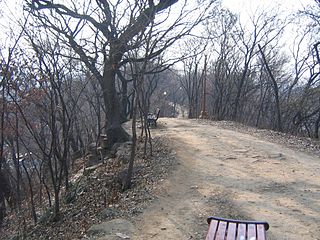 W
WDalseong Park is a park located in Jung-gu, Daegu, South Korea. The park includes Gwanpungnu Pavilion, a local history hall, a zoo, and some monuments.
 W
WThe Dongnaeeupseong Fortress is located on Dongnae-gu, Busan Metropolitan City, Republic of Korea.
 W
WThe Fortress site of Jwasuyeong is located in Suyeong-dong, Suyeong-gu, Busan Metropolitan City, the Republic of Korea. The Fortress site of Jwasuyeong is the site of the main fortress of the Gyeongsangjwado naval forces during the Joseon period. At one time, seven naval ports with a total of 65 battle ships and 40 auxiliary vessels were under its command and charged with the defense of the east coast area.
 W
WThe Fortress Wall of Seoul, or literally the Seoul City Wall is a series of walls made of stone, wood and other materials, built to protect the city of Seoul against invaders. The wall was first built in 1396 to defend and show the boundaries of the city, surrounding Hanyang in the Joseon Dynasty. At that time, it was called Hansung. The wall stretches 18.6 km along the ridge of Seoul's four inner mountains, Bukhansan, Naksan, Namsan, and Inwangsan. At present, a 12-km section of the wall is designated as Historic Site No. 10 (1963) and is protected accordingly, along with the gates, water gates, and signal fire mounds. The northern, eastern, and southern sections of Mt.Nam walls have undergone extensive restoration work, having sustained damage or been entirely destroyed during Japanese imperial rule (1910-1945). The city of Seoul operates the Hanyangdoseong stamp trail tour, which runs along the wall, divided into six trails:Baegak Mounatain Trail Naksan Mounatain Trail Heunginjimun Gate Trail Namsan(Mongmyeoksan) Mountain Trail Sungnyemun Gate Trail Inwangsan Mountain Trail
 W
WGeumjeongsanseong is the largest mountain fortress in the Republic of Korea today. It is located on Geumjeongsan in the Busan Metropolitan City.
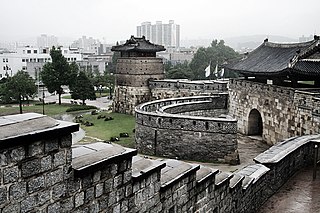 W
WHwaseong Fortress or Suwon Hwaseong is a fortification surrounding the centre of Suwon, the provincial capital of Gyeonggi-do, in South Korea. It was built from 1794 to 1796 by King Jeongjo of the Joseon dynasty to house and honour the remains of his father, Prince Sado. Sado had been executed by being locked alive inside a rice chest by his own father King Yeongjo after failing to obey a command to commit suicide. Located 30 kilometres (19 mi) south of Seoul and enclosing much of central Suwon, the fortress includes King Jeongjo's palace Haenggung. The fortress and enclosed palace were designated as a World Heritage site by UNESCO in 1997. It comprises among many other features the palace, a perimeter wall, four main gates, and two sluicegates over the Suwoncheon, Suwon's main stream, which flows through the centre of the fortress.
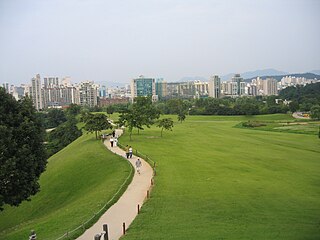 W
WMongchontoseong Earthen Fortification is an ancient earthen rampart dating from the Baekje kingdom. It appears to have played the same role in defending the region the fortifications constructed on Mt. Acha. The fortification walls are estimated to have been about 2.7 kilometres in length and approximately 6 to 7 metres high. The fortifications of Mongchon Toseong had two unique features: a palisade atop the wall and a moat surrounding its base. They are part of Wiryeseong with Pungnaptoseong. It is located what is now in the Olympic Park of Seoul, South Korea. During the 1988 Summer Olympics, the running portion of the modern pentathlon event were hosted there. A number of important excavations of the site were conducted prior to the construction of the nearby Olympic Park.
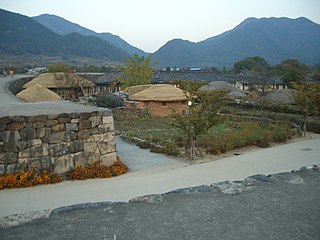 W
WNaganeupseong is a Korean fortress in Nagan-myeon, Suncheon, Jeollanamdo, South Korea.
 W
WNamhae Castle or Namhae Waesong is a Japanese-style castle located on Namhae Island. It was built and used during Hideyoshi's Invasions of Korea between 1593 and 1598.
 W
WNamhansanseong is a historical mountain fortress city 25 km southeast of Seoul, South Korea. It sits approximately 480 m above sea level and is aligned with the ridges of the mountain for maximum defensibility. The fortress, stretching 12 km in length, protects a vast area used as an emergency capital city during the Joseon Dynasty of Korea (1392–1910). The design is based on fortress architecture of East Asia, embodying aspects of four historical cultural styles: the Joseon of Korea, the Azuchi-Momoyama Period of Japan, and Ming and Qing China. It was extensively developed during the 16th to 18th centuries, a period of continuous warfare. The technical development of weaponry and armaments during this period, which saw the use of gunpowder imported from Europe, also greatly influenced the architecture and layout of the fortress. Namhansanseong portrays how the various theories of defense mechanisms in Korea were put to form by combining the everyday living environment with defense objectives. The fortress indicates how Buddhism played an influential role in protecting the state, and it became a symbol of sovereignty in Korea. It stands on the Namhansan, containing fortifications that date back to the 17th century and a number of temples. It can be accessed from Seoul through Namhansanseong Station of Seoul Subway Line 8.
 W
WEarthen Fortification in Pungnap-dong, Seoul is a flat earthen wall built at the edge of the Han River in Korea. It has a circumference of 3.5 km. It is located in modern-day Pungnap-dong, Songpa-gu, Seoul. It used to be included in the neighboring city of Gwangju. It has a long oval shape, spreading to north and south, and leaning slightly toward the east. Based on research conducted during the Japanese occupation, it has been speculated that Pungnap Toseong was Hanam Wiryeseong, the first capital of Baekje.
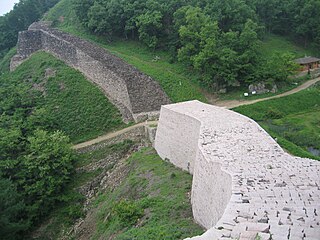 W
WSamnyeon Sanseong Fortress is the ruins of a Silla fortress and wall that was built beginning in the year 470. The fortress was reconstructed in 486. The ruins are located in present-day Boeun, South Korea. During the Three Kingdoms Period the town of Boeun-eup, located two kilometers from the fortress, was known as Samnyeon-gun or Samnyeonsan-gun and it is believed by some that the fortress gets its name from the town. However, the Samguk Sagi relates that the fortress was completed in three years, and that the fortress derived its name from this fact. This account also suggests that the nearby town derived its name from the fortress, rather than vice versa. The Annals of Joseon Dynasty show that the fortress was known as Ojeong Sanseong Fortress and was used during the Joseon Dynasty, probably because the fortress is located atop Mount Ojeongsan.
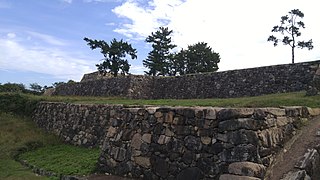 W
WSuncheon Castle, also known as Suncheon Waeseong, in Korean, Juntenjō (順天城) in Japanese, is the only remaining Japanese castle in Jeollanam-do, and the battlefield of Yi Sun-sin who tempted Konishi Yukinaga from here to Noryang Point known as Battle of Noryang Point.
 W
WUlsan Castle, also known as is a Japanese style castle in Ulsan, South Korea which was constructed during the Japanese invasions of Korea by Katō Kiyomasa's army. Today, Ulsan Castle is almost ruined by the city planning of Ulsan.
 W
WWaeseong in Jukseong-ri, Gijang is located in Gijang-gun, Busan Metropolitan City, the Republic of Korea. This is a stone fortress built by the Japanese general, Kuroda Nagamasa who was defending this area against the Korean Joseon army, in about June, 1593, the second year of the Japanese Invasions.